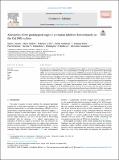Files in this item
Adsorption of the prototypical organic corrosion inhibitor benzotriazole on the Cu(100) surface
Item metadata
| dc.contributor.author | Turano, Marco | |
| dc.contributor.author | Walker, Mark | |
| dc.contributor.author | Grillo, Federico | |
| dc.contributor.author | Gattinoni, Chiara | |
| dc.contributor.author | Hunt, Gregory | |
| dc.contributor.author | Kirkman, Paul | |
| dc.contributor.author | Richardson, Neville V | |
| dc.contributor.author | Baddeley, Christopher John | |
| dc.contributor.author | Costantini, Giovanni | |
| dc.date.accessioned | 2022-09-09T08:30:23Z | |
| dc.date.available | 2022-09-09T08:30:23Z | |
| dc.date.issued | 2022-10 | |
| dc.identifier | 280833772 | |
| dc.identifier | 3615f0ef-9063-4095-b2da-d6b941fbca9a | |
| dc.identifier | 85136129538 | |
| dc.identifier | 000848039700001 | |
| dc.identifier.citation | Turano , M , Walker , M , Grillo , F , Gattinoni , C , Hunt , G , Kirkman , P , Richardson , N V , Baddeley , C J & Costantini , G 2022 , ' Adsorption of the prototypical organic corrosion inhibitor benzotriazole on the Cu(100) surface ' , Corrosion Science , vol. 207 , 110589 . https://doi.org/10.1016/j.corsci.2022.110589 | en |
| dc.identifier.issn | 0010-938X | |
| dc.identifier.other | ORCID: /0000-0001-9750-6494/work/117567795 | |
| dc.identifier.other | ORCID: /0000-0001-9961-1212/work/117567986 | |
| dc.identifier.uri | https://hdl.handle.net/10023/25981 | |
| dc.description | M.T. gratefully acknowledges financial support from Lubrizol Limited and thanks the Engineering and Physical Sciences Research Council (EPSRC) grant EP/L015307/1 for the Molecular Analytical Science Centre for Doctoral Training (MAS-CDT). C.G. acknowledges the use of the Euler cluster at ETH Zurich for the DFT calculations. F.G. acknowledges funding from the EPSRC (grant EP/S027270/1). | en |
| dc.description.abstract | The interaction of benzotriazole (BTAH) with Cu(100) has been studied as a function of BTAH exposure in a joint experimental and theoretical effort. Scanning tunnelling microscopy (STM), X-ray photoelectron spectroscopy (XPS), high resolution electron energy loss spectroscopy (HREELS) and density functional theory (DFT) calculations have been combined to elucidate the structural and chemical characteristics of this system. BTAH is found to deprotonate upon adsorption on the copper surface and to adopt an orientation that depends on the molecular coverage. Benzotriazolate (BTA) species initially lie with their planes parallel to the substrate but, at a higher molecular coverage, a transition occurs to an upright adsorption geometry. Upon increasing the BTAH exposure, different phases of vertically aligned BTAs are observed with increasing molecular densities until a final, self-limiting monolayer is developed. Both theory and experiment agree in identifying CuBTA and Cu(BTA)2 metal-organic complexes as the fundamental building blocks of this monolayer. This work shows several similarities with the results of previous studies on the interaction of benzotriazole with other low Miller index copper surfaces, thereby ideally completing and concluding them. The overall emerging picture constitutes an important starting point for understanding the mechanism for protection of copper from corrosion. | |
| dc.format.extent | 10 | |
| dc.format.extent | 6090226 | |
| dc.language.iso | eng | |
| dc.relation.ispartof | Corrosion Science | en |
| dc.subject | Corrosion inhibitors | en |
| dc.subject | Copper | en |
| dc.subject | STM | en |
| dc.subject | XPS | en |
| dc.subject | HREELS | en |
| dc.subject | DFT | en |
| dc.subject | QD Chemistry | en |
| dc.subject | NDAS | en |
| dc.subject.lcc | QD | en |
| dc.title | Adsorption of the prototypical organic corrosion inhibitor benzotriazole on the Cu(100) surface | en |
| dc.type | Journal article | en |
| dc.contributor.sponsor | EPSRC | en |
| dc.contributor.institution | University of St Andrews. School of Chemistry | en |
| dc.contributor.institution | University of St Andrews. Institute of Behavioural and Neural Sciences | en |
| dc.contributor.institution | University of St Andrews. EaSTCHEM | en |
| dc.identifier.doi | https://doi.org/10.1016/j.corsci.2022.110589 | |
| dc.description.status | Peer reviewed | en |
| dc.identifier.grantnumber | EP/S027270/1 | en |
This item appears in the following Collection(s)
Items in the St Andrews Research Repository are protected by copyright, with all rights reserved, unless otherwise indicated.

